The Armlock
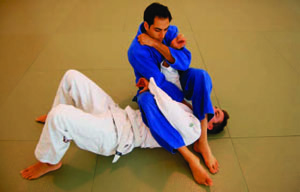
The cross body armlock, or Ude Hishigi Juji Gatame in Japanese, is a fundamental submission used in many jujutsu styles, as well as other martial arts. However, few arts incorporate it into sparring as commonly as Brazilian Jiu Jitsu. It is an effective technique regardless of size, pitting the strength and leverage of an entire body against a single joint, and can be easily used by females in specific self-defense situations.
The cross body armlock is most often achieved from the guard and mount positions.
From the guard, uncross your ankles, and settle one foot on the hip. This foot will be your driving force in turning your torso perpendicular to your opponent.
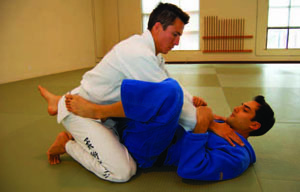
Your other leg should lodge itself as high as possible on your partner's torso, with the back of the knee pressed into the armpit.
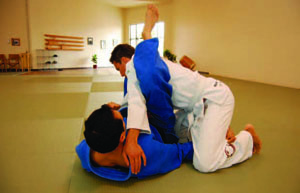
As your body rotates (shown here on the opposite side), you can assist yourself in turning by grabbing under the hamstring. This additional handle is useful for sweeps.
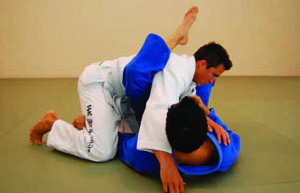
As the leg that originally pushed off the hip swings over your partner's face, it is important to lock down firmly, pulling your heels in at all times, and squeezing your knees together. The legs should be locking independently, with the ankles uncrossed. Lifting your hips from this position, while hugging your opponent’s wrist, creates the hyperextension of the elbow, and the tap from your partner signals to release the joint lock.
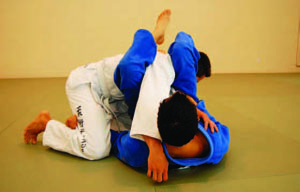
From the mount position, we will use another attack as a distraction to expose the arms.
I start with my right hand deeply inserted in James' collar.
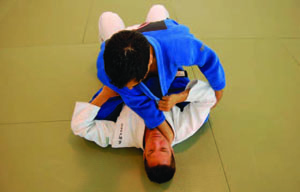
I begin to apply a choke with my left hand.
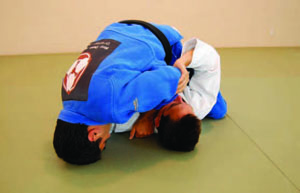
In order to relieve the pressure on his throat, James pushes on my left elbow. I allow him to push my arm as far as I can, sometimes even guiding him to extend his arm more by lightly pulling as I feel his push. While distributing some weight to the outstretched hand, my left knee slides as high as possible. I want the center of my hips to be in line with his shoulder. James is now unable to retract his arm, or more specifically, pull his elbow close to his body.
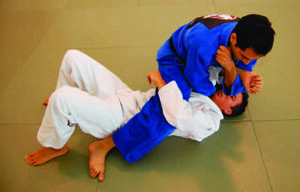
My right ankle is now at James's hip, leaving too much space for possible escapes, and a poor angle for my knee if I need to redistribute my weight forward.
The solution is to flip the angle of my extended leg, so I can transfer weight to the outside of my right thigh, and allowing his torso to bear my bodyweight. This pins him in place and allows the knee that's blocking the arm to swing over his head.
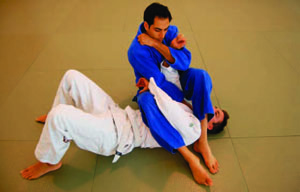
Squeeze the knees together, pull in your heels tightly, hug the wrist with the inside of your elbow, and lower your back to the ground. If necessary, raise your hips to the ceiling while your shoulders remain on the floor.
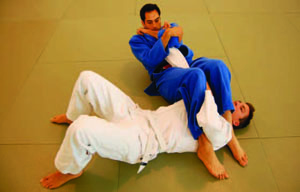
The legs may be required to press into your partner to counter movement or resistance, so angles and leg positions for the armlock may vary, but all achieve the same result.
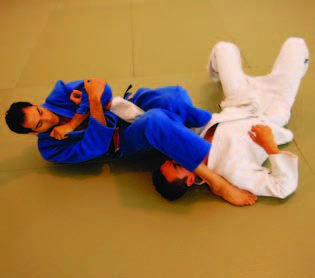
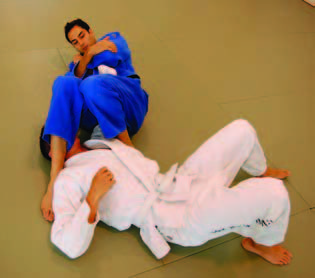
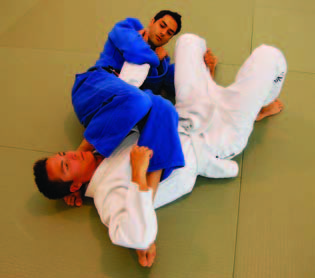
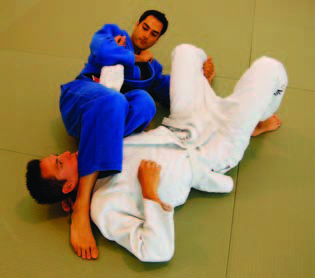
The leg of your opponent may also be grabbed to inhibit their movement, and stabilize your own position.
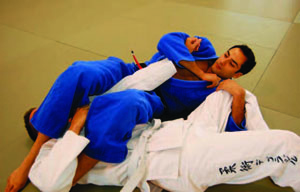
Generally, the leverage for the armlock is better when using the elbow to hook the wrist rather than the hands
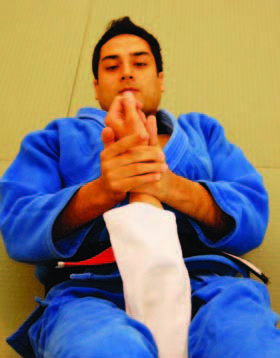
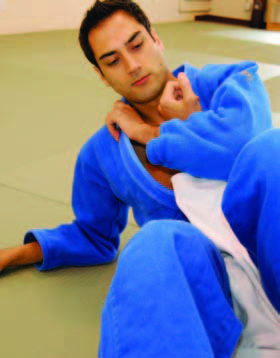
However, there are circumstances where use of the hands is required. In this method of "cheating" the armlock, I begin by throwing my left leg over James' shoulder.
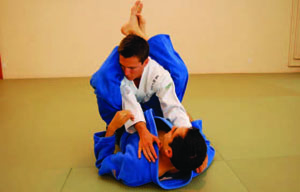
With the shoulder trapped, raise your hips high, until your shoulders, hips, and knees are in a straight line.
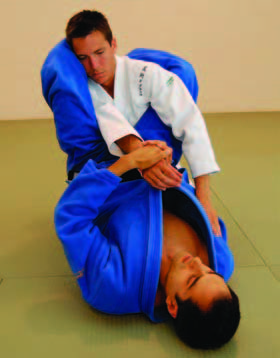
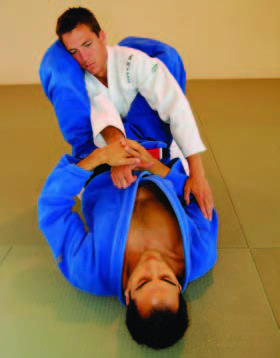
Pull the wrist back, driving the back of his tricep on to the inside of the left thigh. I am pulling his wrist to the left, in the opposite direction of the thumb.
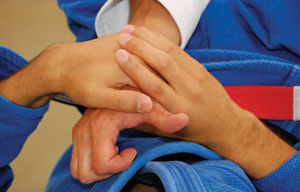
Although there are guidelines for good mechanics, at advanced levels of jiu jitsu, you must adapt your mechanics spontaneously to what is offered by your partner. Leg positions vary, and have different uses, strength and weaknesses. Hand positions and body angles may also vary, yet be equally effective. This extends to all techniques, not just armlocks. Real jiu jitsu is not about secret or signature techniques, it is about adaptation for the positions and situations that we find ourselves in.
Photos by Rick Ellis
The cross body armlock is most often achieved from the guard and mount positions.
From the guard, uncross your ankles, and settle one foot on the hip. This foot will be your driving force in turning your torso perpendicular to your opponent.

Your other leg should lodge itself as high as possible on your partner's torso, with the back of the knee pressed into the armpit.

As your body rotates (shown here on the opposite side), you can assist yourself in turning by grabbing under the hamstring. This additional handle is useful for sweeps.

As the leg that originally pushed off the hip swings over your partner's face, it is important to lock down firmly, pulling your heels in at all times, and squeezing your knees together. The legs should be locking independently, with the ankles uncrossed. Lifting your hips from this position, while hugging your opponent’s wrist, creates the hyperextension of the elbow, and the tap from your partner signals to release the joint lock.

From the mount position, we will use another attack as a distraction to expose the arms.
I start with my right hand deeply inserted in James' collar.

I begin to apply a choke with my left hand.

In order to relieve the pressure on his throat, James pushes on my left elbow. I allow him to push my arm as far as I can, sometimes even guiding him to extend his arm more by lightly pulling as I feel his push. While distributing some weight to the outstretched hand, my left knee slides as high as possible. I want the center of my hips to be in line with his shoulder. James is now unable to retract his arm, or more specifically, pull his elbow close to his body.

My right ankle is now at James's hip, leaving too much space for possible escapes, and a poor angle for my knee if I need to redistribute my weight forward.
The solution is to flip the angle of my extended leg, so I can transfer weight to the outside of my right thigh, and allowing his torso to bear my bodyweight. This pins him in place and allows the knee that's blocking the arm to swing over his head.

Squeeze the knees together, pull in your heels tightly, hug the wrist with the inside of your elbow, and lower your back to the ground. If necessary, raise your hips to the ceiling while your shoulders remain on the floor.

The legs may be required to press into your partner to counter movement or resistance, so angles and leg positions for the armlock may vary, but all achieve the same result.




The leg of your opponent may also be grabbed to inhibit their movement, and stabilize your own position.

Generally, the leverage for the armlock is better when using the elbow to hook the wrist rather than the hands


However, there are circumstances where use of the hands is required. In this method of "cheating" the armlock, I begin by throwing my left leg over James' shoulder.

With the shoulder trapped, raise your hips high, until your shoulders, hips, and knees are in a straight line.


Pull the wrist back, driving the back of his tricep on to the inside of the left thigh. I am pulling his wrist to the left, in the opposite direction of the thumb.

Although there are guidelines for good mechanics, at advanced levels of jiu jitsu, you must adapt your mechanics spontaneously to what is offered by your partner. Leg positions vary, and have different uses, strength and weaknesses. Hand positions and body angles may also vary, yet be equally effective. This extends to all techniques, not just armlocks. Real jiu jitsu is not about secret or signature techniques, it is about adaptation for the positions and situations that we find ourselves in.
Photos by Rick Ellis
|
Roy Dean has continuously studied martial arts since receiving his first degree black belt in Kodokan Judo at age 17. Dedicating himself to grappling arts, by age 24 he had also earned black belts in Aikikai Aikido and Seibukan Jujutsu, as well as a blue belt in Brazilian Jiu-Jitsu under Claudio Franca. Moving to San Diego, Dean focused exclusively on the study of Brazilian Jiu Jitsu under Professor Roy Harris, receiving the prestigious black belt in 2006. Dean has won Brazilian Jiu-Jitsu and submission grappling tournaments, and seeks to teach the refined art of Brazilian Jiu Jitsu at his Academy in Bend, Oregon. www.roydeanacademy.com |
Search Articles
Article Categories
Sort by Author
Sort by Issue & Date
Article Categories
Sort by Author
Sort by Issue & Date

